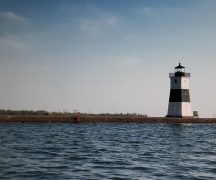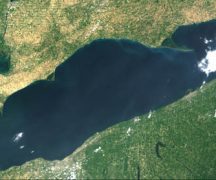From NATIONAL OCEANIC & ATMOSPHERIC ADMINISTRATION
NOAA has detected levels of the harmful toxin, microcystin, in Lake Erie weeks earlier than it is usually detected in routine water tests. While it’s unclear if the toxin originated from Lake Erie or the Maumee River, this April 28 water test is the earliest NOAA’s Great Lakes Environmental Research Lab has detected the toxin growing in Lake Erie.
At certain levels, microcystin toxins produced by certain types of freshwater blue-green algae can pose health risks to people and pets and may also require additional treatment from public drinking water systems.
Reagan Errera, Ph.D., a research ecologist at GLERL in Ann Arbor, Michigan, said water tests taken on April 28 in western Lake Erie showed levels of 0.12 parts per billion of microcystin. This is not a level high enough to trigger treatment measures at nearby drinking water facilities or warnings against swimming or taking pets into an area of the lake, but could pose a problem later in the summer when concentrations are anticipated to rise to above advisory levels for drinking water (1.6 ppb) and recreation (8 ppb). Every summer since 2008, toxin levels have exceeded advisory levels for drinking water and often for recreation in some areas.
“Over the last seven years we have seen the toxic period of the harmful algal bloom starting 10 days earlier than occurred in the period before this,” said Errera. “Early detection of toxins provides drinking water facilities, water managers, and the public more time to make informed decisions regarding the health risk associated with harmful algal bloom events.”
Each year, NOAA begins monthly sampling of Lake Erie in late April and increases the sampling frequency to weekly in June, testing water at eight locations that have historically seen harmful algal blooms. GLERL also tests five sites every two weeks in Saginaw Bay in Lake Huron for harmful algal blooms.
This sampling, which is done by boat, involves testing for 19 water quality parameters including cyanobacteria toxins. These data support NOAA’s Lake Erie HAB Forecast Bulletin serving key constituents such as drinking water supply managers, recreational boaters and the general public. This regular sampling will continue through the 2025 season from April 28 through October to ensure public health and safety.
Harmful algal blooms, which are any algal bloom that is detrimental to the ecosystem or human health, have been detected on every continent except Antarctica, all U.S. coasts including the Atlantic, Pacific, Arctic and Gulf of America, and the five Great Lakes, as well as numerous smaller lake and river systems. These blooms can cause fish kills and can hinder the growth and health of important lake species. Microcystins are the major harmful algal bloom toxin in the Great Lakes that can threaten human health.
Resources:
Lake Erie weekly field sampling data: https://www.glerl.noaa.gov/res/HABs_and_Hypoxia/wle-weekly-current/
Lake Erie HAB forecast products: https://coastalscience.noaa.gov/science-areas/habs/hab-forecasts/lake-erie/
Breakthrough discovery identifies bacteria behind toxin in St. Louis River estuary





